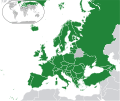Monaco
Monaco (/ˈmɒnəkoʊ/ (![]()
Principality of Monaco Principauté de Monaco (French) Principato di Monaco (Italian) Principat de Mónegue (Occitan) Principatu de Mùnegu (Ligurian)[lower-alpha 1] | |
|---|---|
Motto: "Deo Juvante" (Latin) (English: "With God's Help") | |
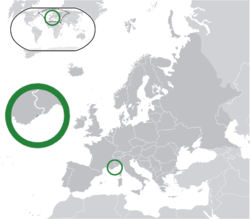 | |
| Largest Quartier | Monte Carlo |
| Official languages | French[1] |
| Common languages | |
| Ethnic groups | |
| Religion | Roman Catholicism (official)[2] |
| Demonym(s) |
|
| Government | Unitary parliamentary constitutional monarchy |
• Monarch | Albert II |
| Serge Telle | |
| Legislature | National Council |
| Independence | |
| 1297 | |
• from the French Empire | 17 May 1814 |
• from occupation of the Sixth Coalition | 17 June 1814 |
• Franco-Monegasque Treaty | 2 February 1861 |
| 1911 | |
| Area | |
• Total | 2.1 km2 (0.81 sq mi) (194th) |
• Water (%) | negligible[3] |
| Population | |
• 2019 estimate | |
• 2016 census | 37,308[5] |
• Density | 18,713/km2 (48,466.4/sq mi) (1st) |
| GDP (PPP) | 2015 estimate |
• Total | |
• Per capita | |
| GDP (nominal) | 2018[b] estimate |
• Total | |
• Per capita | |
| Currency | Euro (€) (EUR) |
| Time zone | UTC+1 (CET) |
| UTC+2 (CEST) | |
| Driving side | right[9] |
| Calling code | +377 |
| ISO 3166 code | MC |
| Internet TLD | .mc |
| |
With an area of 2.1 km2 (0.81 sq mi), it is one of the smallest sovereign states in Europe and the second-smallest in the world, after the Vatican City. Its 19,009 inhabitants per square kilometre (49,230/sq mi), make of it the most densely-populated sovereign state in the world. Monaco has a land border of 5.47 km (3.40 mi),[11] the world's shortest coastline of approximately 3.83 km (2.38 mi), and a width that varies between 1,700 and 349 m (5,577 and 1,145 ft). The highest point in the country is a narrow pathway named Chemin des Révoires on the slopes of Mont Agel, in the Les Révoires Ward, which is 161 metres (528 feet) above sea level. The principality is about 15 km (9.3 mi) from the state border with Italy.[12] Its most populous Quartier is Monte Carlo and the most populous Ward is Larvotto/Bas Moulins. Through land reclamation, Monaco's land mass has expanded by 20 percent. In 2005, it had an area of only 1.974 km2 (0.762 sq mi).
The principality is governed under a form of constitutional monarchy, with Prince Albert II as head of state. Although Prince Albert II is a constitutional monarch, he wields immense political power. The House of Grimaldi has ruled Monaco, with brief interruptions, since 1297.[13] The state's sovereignty was officially recognised by the Franco-Monegasque Treaty of 1861, with Monaco becoming a full United Nations voting member in 1993. Despite Monaco's independence and separate foreign policy, its defence is the responsibility of France. However, Monaco does maintain two small military units.
Economic development was spurred in the late 19th century with the opening of the country's first casino, Monte Carlo, and a railway connection to Paris.[14] Since then, Monaco's mild climate, scenery, and gambling facilities have contributed to the principality's status as a tourist destination and recreation centre for the rich. In more recent years, Monaco has become a major banking centre and has sought to diversify its economy into the services sector and small, high-value-added, non-polluting industries. The state has no income tax, low business taxes, and is well known for being a tax haven. In 2014, it was noted that about 30% of the population was made up of millionaires.[15]
Monaco is not formally a part of the European Union (EU), but it participates in certain EU policies, including customs and border controls. Through its relationship with France, Monaco uses the euro as its sole currency (prior to this it used the Monégasque franc). Monaco joined the Council of Europe in 2004, and is a member of the Organisation Internationale de la Francophonie (OIF). It is also the host of the annual street circuit motor race Monaco Grand Prix, one of the original Grands Prix of Formula One and birthplace of Scuderia Ferrari driver Charles Leclerc. The principality has a club football team, AS Monaco, who have become French champions on multiple occasions.
History
Monaco's name comes from the nearby 6th-century BC Phocaean Greek colony. Referred to by the Ligurians as Monoikos, from the Greek "μόνοικος", "single house", from "μόνος" (monos) "alone, single"[16] + "οἶκος" (oikos) "house",[17] which bears the sense of a people either settled in a "single habitation" or of "living apart" from others.
According to an ancient myth, Hercules passed through the Monaco area and turned away the previous gods.[18] As a result, a temple was constructed there, the temple of Hercules Monoikos. Because the only temple of this area was the "House" of Hercules, the city was called Monoikos.[19][20] It ended up in the hands of the Holy Roman Empire, which gave it to the Genoese.
An ousted branch of a Genoese family, the Grimaldi, contested it for a hundred years before actually gaining control. Though the Republic of Genoa would last until the 19th century, they allowed the Grimaldi family to keep Monaco, and, likewise, both France and Spain left it alone for hundreds of years. France did not annex it until the French Revolution, but after the defeat of Napoleon it was put under the care of the Kingdom of Sardinia.
In the 19th century, when Sardinia became a part of Italy, the region came under French influence again but France allowed it to remain independent. Like France, Monaco was overrun by the Axis powers during the Second World War and for a short time was administered by Italy, then the Third Reich, before finally being liberated. Although the occupation lasted for just a short time, it meant the deportation of the Jewish population and execution of several resistance members from Monaco. Since then Monaco has been independent. It has taken some steps towards integration with the European Union.
Arrival of the Grimaldi family

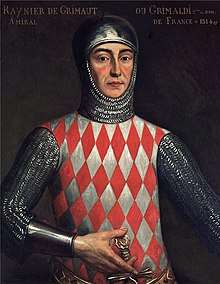
Following a land grant from Emperor Henry VI in 1191, Monaco was refounded in 1215 as a colony of Genoa.[21][22] Monaco was first ruled by a member of the House of Grimaldi in 1297, when Francesco Grimaldi, known as "Il Malizia" (translated from Italian either as "The Malicious One" or "The Cunning One"), and his men captured the fortress protecting the Rock of Monaco while dressed as Franciscan monks—a monaco in Italian, although this is a coincidence as the area was already known by this name.[23]
Francesco, however, was evicted only a few years afterwards by the Genoese forces, and the struggle over "the Rock" continued for another century.[24] The Grimaldi family was Genoese and the struggle was something of a family feud. However, the Genoese became engaged in other conflicts, and in the late 1300s Genoa lost Monaco in a conflict with the Crown of Aragon over Corsica.[25] Aragon eventually became part of Spain, and other parts of the land grant drifted into various pieces of other kingdoms and nations.[25]
1400–1800

In 1419, the Grimaldi family purchased Monaco from the Crown of Aragon and became the official and undisputed rulers of "the Rock of Monaco". In 1612 Honoré II began to style himself "Prince" of Monaco.[26] In the 1630s, he sought French protection against the Spanish forces and, in 1642, was received at the court of Louis XIII "Duc et Pair Etranger".[27]
The princes of Monaco thus became vassals of the French kings while at the same time remaining sovereign princes.[28] Though successive princes and their families spent most of their lives in Paris, and intermarried with French and Italian nobilities, the House of Grimaldi is Italian. The principality continued its existence as a protectorate of France until the French Revolution.[29]
In 1793, Revolutionary forces captured Monaco and it remained under direct French control until 1814, when the Grimaldi family returned to the throne.[27][30]
19th century
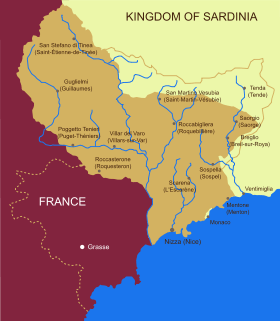
Between 1793 and 1814 Monaco was occupied by the French (in this period much of Europe had been overrun by the French under command of Napoleon).[27][30] The principality was reestablished in 1814 only to be designated a protectorate of the Kingdom of Sardinia by the Congress of Vienna in 1815.[30] Monaco remained in this position until 1860 when, by the Treaty of Turin, the Sardinian forces pulled out of the principality, and the surrounding county of Nice (as well as Savoy) was ceded to France.[31] Monaco became a French protectorate once again.
Before this time there was unrest in Menton and Roquebrune, where the townspeople had become weary of heavy taxation by the Grimaldi family. They declared their independence, hoping for annexation by Sardinia. France protested. The unrest continued until Charles III of Monaco gave up his claim to the two mainland towns (some 95% of the principality at the time) that had been ruled by the Grimaldi family for over 500 years.[32]
These were ceded to France in return for 4,100,000 francs.[33] The transfer and Monaco's sovereignty were recognised by the Franco-Monegasque Treaty of 1861. In 1869, the principality stopped collecting income tax from its residents—an indulgence the Grimaldi family could afford to entertain thanks solely to the extraordinary success of the casino.[34] This made Monaco not only a playground for the rich, but a favoured place for them to live.[35]
20th century
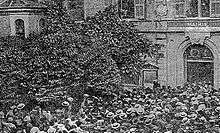
Until the Monegasque Revolution of 1910 forced the adoption of the 1911 constitution, the princes of Monaco were absolute rulers.[36] The new constitution, however, barely reduced the autocratic rule of the Grimaldi family and Prince Albert I soon suspended it during the First World War.
In July 1918, the Franco-Monegasque Treaty was signed, providing for limited French protection over Monaco. The treaty, endorsed in 1919 by the Treaty of Versailles, established that Monegasque international policy would be aligned with French political, military, and economic interests, and resolved the Monaco Succession Crisis.[37]
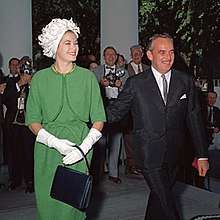
In November 1942, the Italian Army invaded and occupied Monaco, forming a fascist administration.[38]In September 1943, following the collapse of Mussolini, the German Wehrmacht occupied Monaco and the Nazi deportation of the Jewish population began. René Blum, the prominent French Jew who founded the Ballet de l'Opera in Monte Carlo, was arrested in his Paris home and held in the Drancy deportation camp outside the French capital before being transported to the Auschwitz concentration camp, where he was later killed.[39] Blum's colleague Raoul Gunsbourg, the director of the Opéra de Monte-Carlo, helped by the French Resistance, escaped arrest and fled to Switzerland.[40] In August 1944, the Germans executed René Borghini, Joseph-Henri Lajoux and Esther Poggio, who were Resistance leaders.
Rainier III, who ruled until 2005, succeeded to the throne following the death of his grandfather, Prince Louis II, in 1949. On 19 April 1956, Prince Rainier married the American actress Grace Kelly; the event was widely televised and covered in the popular press, focusing the world's attention on the tiny principality.[41]
A 1962 amendment to the constitution abolished capital punishment, provided for women's suffrage, and established a Supreme Court of Monaco to guarantee fundamental liberties.
In 1963, a crisis developed when Charles de Gaulle blockaded Monaco, angered by its status as a tax haven for wealthy French. The 2014 film Grace of Monaco is loosely based on this crisis.[42]
In 1993, the Principality of Monaco became a member of the United Nations, with full voting rights.[31][43]
21st century
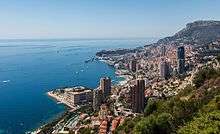
In 2002, a new treaty between France and Monaco specified that, should there be no heirs to carry on the Grimaldi dynasty, the principality would still remain an independent nation rather than revert to France. Monaco's military defence, however, is still the responsibility of France.[44][45]
On 31 March 2005, Rainier III, who was too ill to exercise his duties, relinquished them to his only son and heir, Albert.[46] He died six days later, after a reign of 56 years, with his son succeeding him as Albert II, Sovereign Prince of Monaco.
Following a period of official mourning, Prince Albert II formally assumed the princely crown on 12 July 2005,[47] in a celebration that began with a solemn Mass at Saint Nicholas Cathedral, where his father had been buried three months earlier. His accession to the Monégasque throne was a two-step event with a further ceremony, drawing heads of state for an elaborate reception, held on 18 November 2005, at the historic Prince's Palace in Monaco-Ville.[48]
On 27 August 2015, Albert II apologised for Monaco's role during World War II in facilitating the deportation of a total of 90 Jews and resistance fighters, of whom only nine survived. "We committed the irreparable in handing over to the neighbouring authorities women, men and a child who had taken refuge with us to escape the persecutions they had suffered in France," Albert said at a ceremony in which a monument to the victims was unveiled at the Monaco cemetery. "In distress, they came specifically to take shelter with us, thinking they would find neutrality."[49]
In 2015, Monaco unanimously approved a modest land reclamation expansion intended primarily for some desperately needed housing and a small green/park area.[50]
Monaco had previously considered an expansion in 2008, but called it off.[50] The plan is for about six hectares of apartment buildings, parks, shops and offices for about 1 billion euros for the land.[51] The development will be adjacent to the Larvotto district and also will include a small marina.[51][52] There were four main proposals, and the final mix of use will be finalised as the development progresses.[53] The name for the new district is Anse du Portier.[52]

Government
Monaco has been governed under a constitutional monarchy since 1911, with the Sovereign Prince of Monaco as head of state.[54] The executive branch consists of a Minister of State as the head of government, who presides over a five-member Council of Government.[55] Until 2002, the Minister of State was a French citizen appointed by the prince from among candidates proposed by the French government; since a constitutional amendment in 2002, the Minister of State can be French or Monegasque.[21] On 3 March 2010, Prince Albert II appointed a French citizen, Michel Roger.[56]
Under the 1962 constitution, the prince shares his veto power with the unicameral National Council.[57] The 24 members of the National Council are elected for five-year terms; 16 are chosen through a majority electoral system and 8 by proportional representation.[58] All legislation requires the approval of the National Council, which is currently dominated by the conservative Rally and Issues for Monaco (REM) party which holds 20 seats.[58] Union Monégasque holds three seats[58] while Renaissance holds one seat. The principality's city affairs are directed by the Communal Council,[59] which consists of 14 elected members and is presided over by a mayor.[60] Unlike the National Council, councillors are elected for four-year terms,[61] and are strictly non-partisan; however, oppositions inside the council frequently form.[59][62]
Administrative divisions
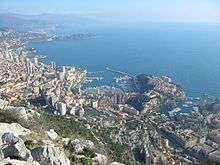
Monaco is the second-smallest country by area in the world; only Vatican City is smaller.[63] Monaco is the most densely populated country in the world.[64] The state consists of only one municipality (commune), the Municipality of Monaco. There is no geographical distinction between the State and City of Monaco, although responsibilities of the government (state-level) and of the municipality (city-level) are different.[56] According to the constitution of 1911, the principality was subdivided into three municipalities:[65]
- Monaco-Ville, the old city and seat of government of the principality on a rocky promontory extending into the Mediterranean, known as the Rock of Monaco, or simply "The Rock";
- Monte Carlo, the principal residential and resort area with the Monte Carlo Casino in the east and northeast;
- La Condamine, the southwestern section including the port area, Port Hercules.
The municipalities were merged into one in 1917, after accusations that the government was acting according to the motto "divide and conquer," and they were accorded the status of Wards or Quartiers thereafter.
- Fontvieille was added as a fourth ward, a newly constructed area claimed from the sea in the 1970s;
- Moneghetti became the fifth ward, created from part of La Condamine;
- Larvotto became the sixth ward, created from part of Monte Carlo;
- La Rousse/Saint Roman (including Le Ténao) became the seventh ward, also created from part of Monte Carlo.
Subsequently, three additional wards were created:
- Saint Michel, created from part of Monte Carlo;
- La Colle, created from part of La Condamine;
- Les Révoires, also created from part of La Condamine.
An additional ward was planned by new land reclamation to be settled beginning in 2014[66] but Prince Albert II announced in his 2009 New Year Speech that he had ended plans due to the economic climate at the time.[67] However, Prince Albert II in mid-2010 firmly restarted the program.[68][69] In 2015, a new development called Anse du Portier was announced.[52]
Traditional quarters and modern geographic areas
The four traditional quartiers of Monaco are Monaco-Ville, La Condamine, Monte Carlo and Fontvieille.[70][71] However, the suburb of Moneghetti, the high-level part of La Condamine, is generally seen today as an effective fifth Quartier of the Monaco, having a very distinct atmosphere and topography when compared with low-level La Condamine.[72]
Wards
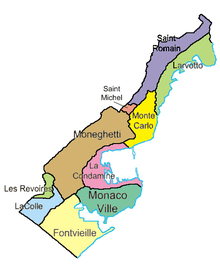
Currently Monaco is subdivided into ten wards, with their official numbers; either Fontvieille II or Le Portier would become the effective eleventh ward, if built:[69][73][74]
| Ward | Area (km²) | Population (Census of 2008) | Density (km²) | City Blocks (îlots) | Remarks | |
|---|---|---|---|---|---|---|
| Former municipality of Monaco | ||||||
| Monaco-Ville | 0.19 | 1,034 | 5,442 | 19 | Old City | |
| Former municipality of Monte Carlo | ||||||
| Monte Carlo/Spélugues (Bd. Des Moulins-Av. de la Madone) | 0.30 | 3,834 | 12,780 | 20 | Casino and resort area | |
| La Rousse/Saint Roman (Annonciade-Château Périgord) | 0.13 | 3,223 | 24,792 | 17 | Northeast area, includes Le Ténao | |
| Larvotto/Bas Moulins (Larvotto-Bd Psse Grace) | 0.34 | 5,443 | 16,009 | 17 | Eastern beach area | |
| Saint Michel (Psse Charlotte-Park Palace) | 0.16 | 3,907 | 24,419 | 24 | Central residential area | |
| Former municipality of La Condamine | ||||||
| La Condamine | 0.28 | 3,947 | 14,096 | 28 | Northwest port area | |
| La Colle (Plati-Pasteur-Bd Charles III) | 0.11 | 2,829 | 25,718 | 15 | On the western border with Cap d'Ail | |
| Les Révoires (Hector Otto-Honoré Labande) | 0.09 | 2,545 | 28,278 | 11 | Contains the Jardin Exotique de Monaco | |
| Moneghetti/ Bd de Belgique (Bd Rainier III-Bd de Belgique) | 0.10 | 3,003 | 30,030 | 17 | Central-north residential area | |
| New land reclaimed from the sea | ||||||
| Fontvieille | 0.35 | 3,901 | 11,146 | 10 | Started 1981 | |
| Monaco[75][76] | 2.05 | 33,666 | 16,422 | 178 | ||
| (1) Not included in the total, as it is only proposed | ||||||
Note: for statistical purposes, the Wards of Monaco are further subdivided into 178 city blocks (îlots), which are comparable to the census blocks in the United States.[75]
- Other possible expansions are Le Portier, a project relaunched in 2012[77]
- Another possibility was Fontvieille II Development to commence in 2013[73][78]
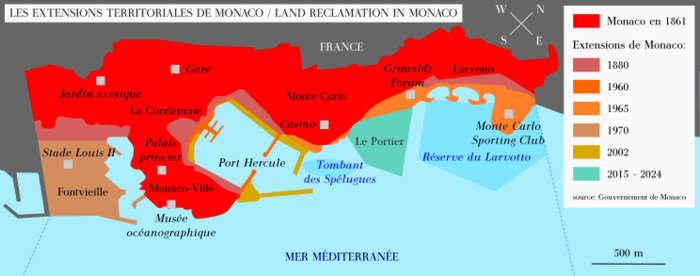
Security
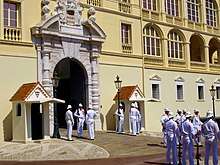
The wider defence of the nation is provided by France. Monaco has no navy or air force, but on both a per-capita and per-area basis, Monaco has one of the largest police forces (515 police officers for about 36,000 people) and police presences in the world.[79] Its police includes a special unit which operates patrol and surveillance boats.[80]
There is also a small military force. This consists of a bodyguard unit for the Prince and the palace in Monaco-Ville called the Compagnie des Carabiniers du Prince (Prince's Company of Carabiniers), which is equipped with weapons such as M16A2 rifles and 9 mm pistols (Glock 17),[81] and which together with the militarised, armed fire and civil defence Corps (Sapeurs-Pompiers) forms Monaco's total public forces.[82] The Compagnie des Carabiniers du Prince was created by Prince Honoré IV in 1817 for the protection of the principality and the Princely family. The company numbers exactly 116 officers and men; while the NCOs and soldiers are local, the officers have generally served in the French Army. In addition to their guard duties as described, the Carabiniers patrol the principality's beaches and coastal waters.[83]
Geography
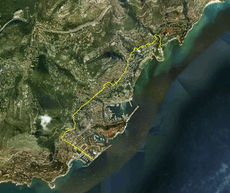
Monaco is a sovereign city state, with five quartiers and ten wards,[84] located on the French Riviera in Western Europe. It is bordered by France's Alpes-Maritimes département on three sides, with one side bordering the Mediterranean Sea. Its centre is about 16 km (9.9 mi) from Italy and only 13 km (8.1 mi) northeast of Nice, France.[43]
It has an area of 2.1 km2 (0.81 sq mi), or 208 hectares (510 acres), and a population of 38,400,[85] making Monaco the second-smallest and the most densely populated country in the world.[43] The country has a land border of only 5.47 km (3.40 mi),[85] a coastline of 3.83 km (2.38 mi), a maritime claim that extends 22.2 kilometres (13.8 mi), and a width that varies between 1,700 and 349 m (5,577 and 1,145 ft).[86][87]
The highest point in the country is at the access to the Patio Palace residential building on the Chemin des Révoires (ward Les Révoires) from the D6007 (Moyenne Corniche street) at 164.4 metres (539 feet) above sea level.[88] The lowest point in the country is the Mediterranean Sea.[89]
Saint-Jean is the longest flowing body of water, around 0.19 km (190 metres; 0.12 miles; 620 feet) in length, and Fontvieille is the largest lake, approximately 0.5 ha (5,000.00 m2; 1.24 acres; 53,819.55 sq ft) in area.[90] Monaco's most populated quartier is Monte Carlo, and the most populated ward is Larvotto/Bas Moulins.[75]
After a recent expansion of Port Hercules,[91] Monaco's total area grew to 2.02 km2 (0.78 sq mi) or 202 hectares (500 acres);[75] consequently, new plans have been approved to extend the district of Fontvieille by 0.08 km2 (0.031 sq mi) or 8 hectares (20 acres), with land reclaimed from the Mediterranean Sea. Current land reclamation projects include extending the district of Fontvieille.[92][93][94][91][95] There are two ports in Monaco, Port Hercules and Port Fontvieille.[96] Monaco's only natural resource is fishing;[97] with almost the entire country being an urban area, Monaco lacks any sort of commercial agriculture industry. There is a neighbouring French port called Cap d'Ail that is near Monaco.[96]

Architecture
Monaco exhibits a wide range of architecture, but the principality's signature style, particularly in Monte Carlo, is that of the Belle Epoque. It finds its most florid expression in the 1878–9 Casino and the Salle Garnier created by Charles Garnier and Jules Dutrou. Decorative elements include turrets, balconies, pinnacles, multi-coloured ceramics, and caryatids. These were blended to create a picturesque fantasy of pleasure and luxury, and an alluring expression of how Monaco sought, and still seeks, to portray itself.[98] This capriccio of French, Italian, and Spanish elements was incorporated into hacienda villas and apartments. Following major development in the 1970s, Prince Rainier III banned high-rise development in the principality. His successor, Prince Albert II, overturned this Sovereign Order.[99] In recent years the accelerating demolition of Monaco's architectural heritage, including its single-family villas, has created dismay.[100] The principality currently has no heritage protection legislation.[101]
Climate
Monaco has a hot-summer Mediterranean climate (Köppen climate classification: Csa), which is influenced by oceanic climate (Cfb) and humid subtropical climate (Cfa). As a result, it has warm, dry summers and mild, rainy winters.[102] Cool and rainy interludes can interrupt the dry summer season, the average length of which is also shorter. Summer afternoons are infrequently hot (indeed, temperatures greater than 30 °C or 86 °F are rare) as the atmosphere is temperate because of constant sea breezes. On the other hand, the nights are very mild, due to the fairly high temperature of the sea in summer. Generally, temperatures do not drop below 20 °C (68 °F) in this season. In the winter, frosts and snowfalls are extremely rare and generally occur once or twice every ten years.[103][104] On February 27, 2018, both Monaco and Monte Carlo experienced snowfall.[105]
| Climate data for Monaco (1981–2010 averages, extremes 1966–present) | |||||||||||||
|---|---|---|---|---|---|---|---|---|---|---|---|---|---|
| Month | Jan | Feb | Mar | Apr | May | Jun | Jul | Aug | Sep | Oct | Nov | Dec | Year |
| Record high °C (°F) | 19.9 (67.8) |
23.2 (73.8) |
25.6 (78.1) |
26.2 (79.2) |
30.3 (86.5) |
32.5 (90.5) |
34.4 (93.9) |
34.5 (94.1) |
33.1 (91.6) |
29.0 (84.2) |
25.0 (77.0) |
22.3 (72.1) |
34.5 (94.1) |
| Average high °C (°F) | 13.0 (55.4) |
13.0 (55.4) |
14.9 (58.8) |
16.7 (62.1) |
20.4 (68.7) |
23.7 (74.7) |
26.6 (79.9) |
26.9 (80.4) |
24.0 (75.2) |
20.6 (69.1) |
16.5 (61.7) |
13.9 (57.0) |
19.2 (66.6) |
| Daily mean °C (°F) | 10.2 (50.4) |
10.2 (50.4) |
12.0 (53.6) |
13.8 (56.8) |
17.5 (63.5) |
20.9 (69.6) |
23.8 (74.8) |
24.2 (75.6) |
21.1 (70.0) |
17.9 (64.2) |
13.8 (56.8) |
11.2 (52.2) |
16.4 (61.5) |
| Average low °C (°F) | 7.4 (45.3) |
7.4 (45.3) |
9.1 (48.4) |
10.9 (51.6) |
14.6 (58.3) |
18.0 (64.4) |
21.0 (69.8) |
21.4 (70.5) |
18.3 (64.9) |
15.2 (59.4) |
11.2 (52.2) |
8.5 (47.3) |
13.6 (56.5) |
| Record low °C (°F) | −3.1 (26.4) |
−5.2 (22.6) |
−3.1 (26.4) |
3.8 (38.8) |
7.5 (45.5) |
9.0 (48.2) |
10.5 (50.9) |
12.4 (54.3) |
10.5 (50.9) |
6.5 (43.7) |
1.6 (34.9) |
−1.0 (30.2) |
−5.2 (22.6) |
| Average precipitation mm (inches) | 67.7 (2.67) |
48.4 (1.91) |
41.2 (1.62) |
71.3 (2.81) |
49.0 (1.93) |
32.6 (1.28) |
13.7 (0.54) |
26.5 (1.04) |
72.5 (2.85) |
128.7 (5.07) |
103.2 (4.06) |
88.8 (3.50) |
743.6 (29.28) |
| Average precipitation days (≥ 1.0 mm) | 6.0 | 4.9 | 4.5 | 7.3 | 5.5 | 4.1 | 1.7 | 2.5 | 5.1 | 7.3 | 7.1 | 6.5 | 62.4 |
| Mean monthly sunshine hours | 149.8 | 158.9 | 185.5 | 210.0 | 248.1 | 281.1 | 329.3 | 296.7 | 224.7 | 199.0 | 155.2 | 136.5 | 2,574.7 |
| Source 1: Météo France[106] | |||||||||||||
| Source 2: Monaco website (sun only)[107] | |||||||||||||
| Climate data for Monaco | |||||||||||||
|---|---|---|---|---|---|---|---|---|---|---|---|---|---|
| Month | Jan | Feb | Mar | Apr | May | Jun | Jul | Aug | Sep | Oct | Nov | Dec | Year |
| Average sea temperature °C (°F) | 13.4 (56.2) |
13.0 (55.5) |
13.4 (56.1) |
14.6 (58.4) |
18.0 (64.3) |
21.8 (71.3) |
23.1 (73.6) |
23.6 (74.4) |
22.2 (71.9) |
19.6 (67.2) |
17.4 (63.3) |
14.9 (58.9) |
17.9 (64.3) |
| Source: Weather Atlas[108] | |||||||||||||
Economy
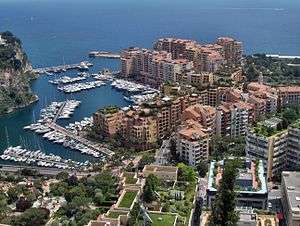
Monaco has the world's highest GDP nominal per capita at US$185,742 GDP PPP per capita at $132,571 and GNI per capita at $183,150.[109][110][111] It also has an unemployment rate of 2%,[112] with over 48,000 workers who commute from France and Italy each day.[75] According to the CIA World Factbook, Monaco has the world's lowest poverty rate[113] and the highest number of millionaires and billionaires per capita in the world.[114] For the fourth year in a row, Monaco in 2012 had the world's most expensive real estate market, at $58,300 per square metre.[115][116][117]
One of Monaco's main sources of income is tourism. Each year many foreigners are attracted to its casino and pleasant climate.[87][118] It has also become a major banking centre, holding over €100 billion worth of funds.[119] Banks in Monaco specialise in providing private banking, asset and wealth management services.[120] The principality has successfully sought to diversify its economic base into services and small, high-value-added, non-polluting industries, such as cosmetics and biothermics.[113]
The state retains monopolies in numerous sectors, including tobacco and the postal service. The telephone network (Monaco Telecom) used to be fully owned by the state; it now owns only 45%, while the remaining 55% is owned by both Cable & Wireless Communications (49%) and Compagnie Monégasque de Banque (6%). It is still, however, a monopoly. Living standards are high, roughly comparable to those in prosperous French metropolitan areas.[121]
Monaco is not a member of the European Union. However, it is very closely linked via a customs union with France and, as such, its currency is the same as that of France, the euro. Before 2002, Monaco minted its own coins, the Monegasque franc. Monaco has acquired the right to mint euro coins with Monegasque designs on its national side.
Gambling industry
The plan for casino gambling was drafted during the reign of Florestan I in 1846. Under Louis-Philippe's petite-bourgeois regime, however, a dignitary such as the Prince of Monaco was not allowed to operate a gambling house.[21] All this changed in the dissolute Second French Empire under Napoleon III. The House of Grimaldi was in dire need of money.
The towns of Menton and Roquebrune, which had been the main sources of income for the Grimaldi family for centuries, were now accustomed to a much improved standard of living and lenient taxation thanks to Sardinian intervention and clamored for financial and political concession, even for separation. The Grimaldi family hoped the newly legal industry would help alleviate the difficulties they faced, above all the crushing debt the family had incurred, but Monaco's first casino would not be ready to operate until after Charles III assumed the throne in 1856.
The grantee of the princely concession (licence) was unable to attract enough business to sustain the operation and, after relocating the casino several times, sold the concession to French casino magnates François and Louis Blanc for 1.7 million francs.
The Blancs had already set up a highly successful casino (in fact the largest in Europe) in Bad-Homburg in the Grand Duchy of Hesse-Homburg, a small German principality comparable to Monaco, and quickly petitioned Charles III to rename a depressed seaside area known as "Les Spelegures (Den of Thieves)" to "Monte Carlo (Mount Charles)."[122] They then constructed their casino in the newly dubbed "Monte Carlo" and cleared out the area's less-than-savory elements to make the neighbourhood surrounding the establishment more conducive to tourism.
The Blancs opened Le Grand Casino de Monte Carlo in 1858 and the casino benefited from the tourist traffic the newly built French railway system created.[123] Due to the combination of the casino and the railroads, Monaco finally recovered from the previous half-century of economic slump and the principality's success attracted other businesses.[124] In the years following the casino's opening, Monaco founded its Oceanographic Museum and the Monte Carlo Opera House, 46 hotels were built and the number of jewelers operating in Monaco increased by nearly five-fold. In an apparent effort to not overtax citizens, it was decreed that the Monégasque citizens were prohibited from entering the casino unless they were employees.[125] By 1869, the casino was making such a vast sum of money that the principality could afford to end tax collection from the Monegasques—a master stroke that was to attract affluent residents from all over Europe in a policy that still exists today.
Today, Société des bains de mer de Monaco, which owns Le Grand Casino, still operates in the original building that the Blancs constructed and has since been joined by several other casinos, including the Le Casino Café de Paris, the Monte Carlo Sporting Club & Casino and the Sun Casino. The most recent addition in Monte Carlo is the Monte Carlo Bay Casino, which sits on 4 hectares of the Mediterranean Sea and, among other things, offers 145 slot machines, all equipped with "ticket-in, ticket-out" (TITO); it is the first Mediterranean casino to use this technology.[126]
Taxes
Monaco has high social-insurance taxes, payable by both employers and employees. The employers' contributions are between 28% and 40% (averaging 35%) of gross salary, including benefits, and employees pay a further 10% to 14% (averaging 13%).[127]
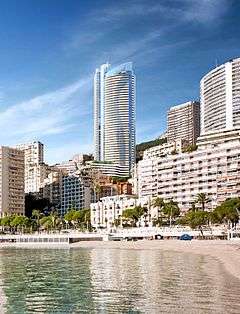
Monaco has never levied income tax on individuals,[92] and foreigners are thus able to use it as a "tax haven" from their own country's high taxes, because as an independent country, Monaco is not obligated to pay taxes to other countries.[128][129]
The absence of a personal income tax has attracted many wealthy "tax refugee" residents from European countries, who derive the majority of their income from activity outside Monaco. Celebrities, such as Formula One drivers, attract most of the attention but the vast majority are lesser-known business people.[130]
However, due to a bilateral treaty with France, French citizens who reside in Monaco must still pay income and wealth taxes to France.[131] The principality also actively discourages the registration of foreign corporations, charging a 33 per cent corporation tax on profits, unless they can show that at least three-quarters of turnover is generated within Monaco. Unlike classic tax havens, Monaco does not offer offshore financial services.[92]
In 1998, the Centre for Tax Policy and Administration, part of the Organisation for Economic Co-operation and Development (OECD), issued a first report on the consequences of the financial systems of known tax havens.[132] Monaco did not appear in the list of these territories until 2004, when the OECD became indignant regarding the Monegasque situation and denounced it in a report, along with Andorra, Liechtenstein, Liberia, and the Marshall Islands. The report underlined Monaco's lack of co-operation regarding financial information disclosure and availability.[133][134] Later, Monaco overcame the OECD's objections and was removed from the "grey list" of uncooperative jurisdictions. In 2009, Monaco went a step farther, and secured a place on the "white list", after signing twelve information exchange treaties with other jurisdictions.[92]
In 2000, the Financial Action Task Force on Money Laundering (FATF) stated: "The anti-money laundering system in Monaco is comprehensive. However, difficulties have been encountered with Monaco by countries in international investigations on serious crimes that appear to be linked also with tax matters. In addition, the FIU of Monaco (SICCFIN) suffers a great lack of adequate resources. The authorities of Monaco have stated that they will provide additional resources to SICCFIN."[135]
Also in 2000, a report by the French parliamentarians Arnaud Montebourg and Vincent Peillon stated that Monaco had relaxed policies with respect to money laundering, including within its casino, and that the government of Monaco had been placing political pressure on the judiciary, so that alleged crimes were not being properly investigated.[136] In its Progress Report of 2005, the International Monetary Fund (IMF) identified Monaco, along with 36 other territories, as a tax haven,[137] but in its FATF report of the same year it took a positive view of Monaco's measures against money-laundering.[138][139]
The Council of Europe also decided to issue reports naming tax havens. Twenty-two territories, including Monaco, were thus evaluated between 1998 and 2000 on a first round. Monaco was the only territory that refused to perform the second round, between 2001 and 2003, whereas the 21 other territories had planned implementing the third and final round, planned between 2005 and 2007.[140]
Numismatics
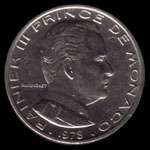
Of interest to numismatists, in Monaco the euro was introduced in 2002, having been preceded by the Monégasque franc.[141] In preparation for this date, the minting of the new euro coins started as early as 2001. Like Belgium, Finland, France, the Netherlands, and Spain, Monaco decided to put the minting date on its coins. This is why the first euro coins from Monaco have the year 2001 on them, instead of 2002, like the other countries of the Eurozone that decided to put the year of first circulation (2002) on their coins.[142][143] Three different designs were selected for the Monégasque coins.[144] However, in 2006, the design was changed after the death of ruling Prince Rainier to have the effigy of Prince Albert.[144][145]
Monaco also mints collectors' coins, with face value ranging from €5 to €100.[146] These coins are a legacy of an old national practice of minting silver and gold commemorative coins.[147][148] Unlike normal issues, these coins are not legal tender in all the Eurozone.[149] The same practice concerning commemorative coins is exercised by all eurozone countries.
Population
Demographics
Monaco's total population was 38,400 in 2015.[150] Monaco's population is unusual in that the native Monégasques are a minority in their own country: the largest group are French nationals at 28.4%, followed by Monégasque (21.6%), Italian (18.7%), British (7.5%), Belgian (2.8%), German (2.5%), Swiss (2.5%) and U.S. nationals (1.2%).[151]
Citizens of Monaco, whether born in the country or naturalised, are called Monégasque.[152] Monaco has the world's highest life expectancy at nearly 90 years.[153][154]
Language
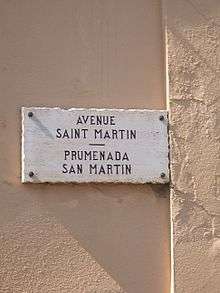
The official language of Monaco is French, while Italian is spoken by the principality's sizeable community from Italy. French and Italian are in fact more spoken in the principality today than Monégasque, its historic vernacular language. A dialect of Ligurian, Monégasque is not recognised as an official language; nevertheless, some signage appears in both French and Monégasque, and the language is taught in schools. English is used by American, British, Anglo-Canadian, and Irish residents.
The Grimaldi, princes of Monaco, have Ligurian origin, thus, the traditional national language is Monégasque, a variety of Ligurian, now spoken by only a minority of residents and as a common second language by many native residents. In Monaco-Ville, street signs are printed in both French and Monégasque.[155][156]
Religion
Christian
Christians comprise a total of 86% of Monaco's population.[157]
According to Monaco 2012 International Religious Freedom Report, Roman Catholics are Monaco's largest religious group, followed by Protestant Christians. The Report states that there are two Protestant churches, an Anglican church and a Reformed church. There are also various other Evangelical Protestant communities that gather periodically.
Roman Catholicism
The official religion is Roman Catholicism, with freedom of other religions guaranteed by the constitution.[158] There are five Catholic parish churches in Monaco and one cathedral, which is the seat of the archbishop of Monaco.
The diocese, which has existed since the mid-19th century, was raised to a non-metropolitan archbishopric in 1981 as the Archdiocese of Monaco and remains exempt (i.e. immediately subject to the Holy See). The patron saint is Saint Devota.
Anglican Communion
There is one Anglican church (St Paul's Church), located in the Avenue de Grande Bretagne in Monte Carlo. The church was dedicated in 1925. In 2007 this had a formal membership of 135 Anglicans resident in the principality, but was also serving a considerably larger number of Anglicans temporarily in the country, mostly as tourists. The church site also accommodates an English-language library of over 3,000 books.[159] The church is part of the Anglican Diocese in Europe.
Reformed Church of Monaco
There is one Reformed church, located in the Rue Louis Notari. This church was built in 1958/1959. It is affiliated to the United Protestant Church of France (Eglise Protestante Unie de France, EPUF), a grouping that incorporates the former Reformed Church of France (Eglise Reformée de France). Through its affiliation with EPUF, the church is part of the World Communion of Reformed Churches. The Reformed Church of Monaco acts as a host-church to some other Christian communities, in that it allows them to use its Rue Louis Notari building.
Charismatic Episcopal Church
The Monaco Parish of the Charismatic Episcopal Church (Parish of St Joseph) dates from 2017 and meets in the Reformed Church's Rue Louis Notari building.
Christian Fellowship
The Monaco Christian Fellowship, formed in 1996, meets in the Reformed Church's Rue Louis Notari building.
Greek Orthodoxy
Monaco's 2012 International Religious Freedom Report states that there is one Greek Orthodox church in Monaco.
Russian Orthodox
The Russian Orthodox Parish of the Holy Royal Martyrs meets in the Refomed Church's Rue Louis Notari building.
Judaism
The Association Culturelle Israélite de Monaco (founded in 1948) is a converted house containing a synagogue, a community Hebrew school, and a kosher food shop, located in Monte Carlo.[160] The community mainly consists of retirees from Britain (40%) and North Africa. Two-thirds of the Jewish population is Sephardic, mainly from North Africa, while the other third is Ashkenazi.[161]
Islam
The Muslim population of Monaco consists of about 280 people, most of whom are residents not citizens.[162] The majority of the Muslim population of Monaco are Arabs, though there are smaller Turkish minorities as well.[163] Monaco does not have any official mosques.[164] There is a mosque in nearby Beausoleil, France, within easy walking distance of Monaco.
Sports
Formula One
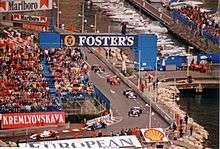
Since 1929, the Monaco Grand Prix has been held annually in the streets of Monaco.[165] It is widely considered to be one of the most prestigious automobile races in the world. The erection of the Circuit de Monaco takes six weeks to complete and the removal after the race takes another three weeks.[165]
The circuit is incredibly narrow and tight and its tunnel, tight corners and many elevation changes make it perhaps the most demanding Formula One track.[166] Driver Nelson Piquet compared driving the circuit to "riding a bicycle around your living room".
Despite the challenging nature of the course it has only had two fatalities, Luigi Fagioli who died from injuries received in practice for the 1952 Monaco Grand Prix (run to sports car regulations that year, not Formula 1)[167] and Lorenzo Bandini, who crashed, burned and died three days later from his injuries in 1967.[168] Two other drivers had lucky escapes after they crashed into the harbour, the most famous being Alberto Ascari in the 1955 Monaco Grand Prix and Paul Hawkins, during the 1965 race.[165]
Monaco also holds a Grand Prix winner, in the form of Charles Leclerc, who has won two races so far in his career, at the 2019 Belgian Grand Prix and 2019 Italian Grand Prix.
Formula E
Starting in 2015 Formula E started racing biennially with the Historic Grand Prix of Monaco on the Monaco ePrix[169] and used a shorter course of the full Formula 1 course, keeping it around Port Hercules.
Monte Carlo Rally
Since 1911 part of the Monte Carlo Rally has been held in the principality, originally held at the behest of Prince Albert I. Like the Grand Prix, the rally is organised by Automobile Club de Monaco. It has long been considered to be one of the toughest and most prestigious events in rallying and from 1973 to 2008 was the opening round of the World Rally Championship (WRC).[170] From 2009 until 2011, the rally served as the opening round of the Intercontinental Rally Challenge.[171] The rally returned to the WRC calendar in 2012 and has been held annually since.[172] Due to Monaco's limited size, all but the ending of the rally is held on French territory.
Football
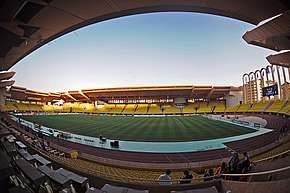
Monaco hosts two major football teams in the principality: the men's football club, AS Monaco FC, and the women's football club, OS Monaco. AS Monaco plays at the Stade Louis II and competes in Ligue 1 the first division of French football. The club is historically one of the most successful clubs in the French league, having won Ligue 1 eight times (most recently in 2016–17) and competed at the top level for all but six seasons since 1953. The club reached the 2004 UEFA Champions League Final, with a team that included Dado Pršo, Fernando Morientes, Jérôme Rothen, Akis Zikos and Ludovic Giuly, but lost 3–0 to Portuguese team FC Porto. French World Cup-winners Thierry Henry, Fabien Barthez, David Trezeguet, and Kylian Mbappe have played for the club. The Stade Louis II also played host to the annual UEFA Super Cup (1998–2012) between the winners of the UEFA Champions League and the UEFA Europa League.
The women's team, OS Monaco, competes in the women's French football league system. The club currently plays in the local regional league, deep down in the league system. It once played in the Division 1 Féminine, in the 1994–95 season, but was quickly relegated.
The Monaco national football team represents the nation in association football and is controlled by the Monégasque Football Federation, the governing body for football in Monaco. However, Monaco is one of only two sovereign states in Europe (along with the Vatican City) that is not a member of UEFA and so does not take part in any UEFA European Football Championship or FIFA World Cup competitions. The team plays its home matches in the Stade Louis II.
Rugby
Monaco's national rugby team, as of April 2019, is 101st in the World Rugby Rankings.[173]
Basketball
Multi-sport club AS Monaco owns AS Monaco Basket which was founded in 1928. They play in France top flight in Basketball LNB Pro A while participating in the EuroCup. They currently have three Pro A Leaders Cup, two Pro B(Second tier), one NM1(Third tier) championship. They currently play in Salle Gaston Médecin what part of Stade Louis II.
Other sports
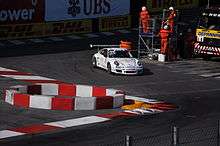
The Monte-Carlo Masters is held annually in neighbouring Roquebrune-Cap-Martin, France, as a professional tournament for men as part of tennis's ATP Masters Series.[174] The tournament has been held since 1897. Golf's Monte Carlo Open was also held at the Monte Carlo Golf Club at Mont Agel in France between 1984 and 1992.
Monaco has a national Davis Cup team, which plays in the European/African Zone.
Monaco has also competed in the Olympic Games, although, no athlete from Monaco has ever won an Olympic medal. At the Youth Olympic Winter Games, Monaco won a bronze medal in bobsleigh.
The 2009 Tour de France, the world's premier cycle race, started from Monaco with a 15-kilometre (9 mi) closed-circuit individual time trial starting and finishing there on the first day, and the 182-kilometre (113 mi) second leg starting there on the following day and ending in Brignoles, France.[175]
Monaco has also staged part of the Global Champions Tour (International Show-jumping).[176] In 2009, the Monaco stage of the Global Champions tour took place between 25–27 June.
The Monaco Marathon is the only marathon in the world to pass through three separate countries, those of Monaco, France and Italy, before the finish at the Stade Louis II.
The Monaco Ironman 70.3 triathlon race is an annual event with over 1,000 athletes competing and attracts top professional athletes from around the world. The race includes a 1.9-kilometre (1.2-mile) swim, 90-kilometre (56-mile) bike ride and 21.1-kilometre (13.1-mile) run.
Since 1993, the headquarters of the International Association of Athletics Federations,[177] the world governing body of athletics, is located in Monaco.[178] An IAAF Diamond League meet is annually held at Stade Louis II.[179]
A municipal sports complex, the Rainier III Nautical Stadium in the Port Hercules district consists of a heated saltwater Olympic-size swimming pool, diving boards and a slide.[180] The pool is converted into an ice rink from December to March.[180]
With Formula One Monaco GP it has some supporter series, FIA Formula 2 and Porsche Supercup. It has in the past also hosted Formula Three and other Formula Junior programs.
From 10–12 July 2014 Monaco inaugurated the Solar1 Monte Carlo Cup, a series of ocean races exclusively for solar-powered boats.[181],[182]
The women team of the chess club CE Monte Carlo won the European Chess Club Cup several times.
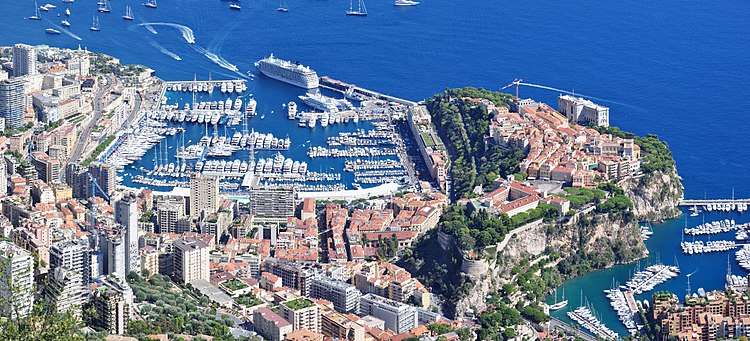
Culture
Music
.jpg)
Monaco has an opera house, a symphony orchestra and a classical ballet company.[183]
Visual arts
Monaco has a national museum of contemporary visual art at the New National Museum of Monaco. The country also has numerous works of public art, statues, museums, and memorials (see list of public art in Monaco).
Museums in Monaco
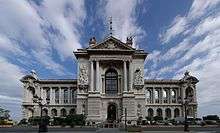
- Monaco Top Cars Collection
- Napoleon Museum (Monaco)
- Oceanographic Museum
Events, festivals and shows
The Principality of Monaco hosts major international events such as :
Bread Festival
Monaco also has an annual bread festival on September 17 every year.[184].
Education
Primary and secondary schools
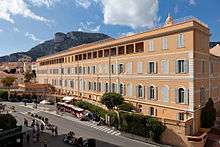
Monaco has ten state-operated schools, including: seven nursery and primary schools; one secondary school, Collège Charles III;[185] one lycée that provides general and technological training, Lycée Albert 1er;[186] and one lycée that provides vocational and hotel training, Lycée technique et hôtelier de Monte-Carlo.[187] There are also two grant-aided denominational private schools, Institution François d'Assise Nicolas Barré and Ecole des Sœurs Dominicaines, and one international school, the International School of Monaco,[188][189] founded in 1994.[190]
Colleges and universities
There is one university located in Monaco, namely the International University of Monaco (IUM), an English-language school specializing in business education and operated by the Institut des hautes études économiques et commerciales (INSEEC) group of schools.
Flag

The flag of Monaco is one of the world's oldest national flag designs.[191] Adopted by Monaco on April 4, 1881, it is almost identical to the flag of Indonesia (adopted by Indonesia in August 17, 1945) except for the ratio of height to width.[192]
Transport
The Monaco-Monte Carlo station is served by the SNCF, the French national rail system. The Monaco Heliport provides helicopter service to the closest airport, Côte d'Azur Airport in Nice, France.
The Monaco bus company (CAM) covers all the tourist attractions, museums, Exotic garden, business centres, and the Casino or the Louis II Stadium.[193]
Relations with other countries
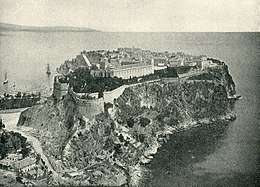
Monaco is so old that it has outlived many of the nations and institutions that it has had relations with. The Crown of Aragon and Republic of Genoa became a part of other countries, as did the Kingdom of Sardinia. Honoré II, Prince of Monaco secured recognition of his independent sovereignty from Spain in 1633, and then from Louis XIII of France by the Treaty of Péronne (1641).
Monaco made a special agreement with France in 1963 in which French customs laws apply in Monaco and its territorial waters.[131] Monaco uses the euro but is not a member of the European Union.[131] Monaco shares a 6-kilometre (3.7-mile) border with France but also has about 2-kilometre (1.2-mile) of coastline with the Mediterranean sea.[194] Two important agreements that support Monaco's independence from France include the Franco-Monégasque Treaty of 1861 and the French Treaty of 1918 (see also Kingdom of Sardinia). The United States CIA Factbook records 1419 as the year of Monaco's independence.[194]
There are two embassies in Monaco: those of France and Italy.[195] There are about another 30 or so consulates.[195] By the 21st century Monaco maintained embassies in Belgium (Brussels), France (Paris), Germany (Berlin), the Vatican, Italy (Rome), Spain (Madrid), Switzerland (Bern), United Kingdom (London) and the United States (Washington).[195]
In the year 2000 nearly two-thirds of the residents of Monaco were foreigners.[196] In 2015 the immigrant population was estimated at 60%[194] However, it is reported to be difficult to gain citizenship in Monaco, or at least in relative number there are not many people who do so.[183] In 2015 an immigration rate of about 4 people per 1,000 was noted, which works out to about 100–150 people a year.[197] The population of Monaco went from 35,000 in 2008 to 36,000 in 2013, and of that about 20 percent were native Monegasque[198] (see also Nationality law of Monaco).
A recurring issue Monaco encounters with other countries is the attempt by foreign nationals to use Monaco to avoid paying taxes in their own country.[194] Monaco actually collects a number of taxes including a 20% VAT and 33% on companies unless they make over 75% of their income inside Monaco.[194] Monaco does not allow dual citizenship, but does have multiple paths to citizenship including by declaration and naturalisation.[199] In many cases the key issue for obtaining citizenship, rather than attaining residency in Monaco, is the person's ties to their departure country.[199] For example, French citizens must still pay taxes to France even if they live full-time in Monaco unless they resided in the country before 1962 for at least 5 years.[199] In the early 1960s there was some tension between France and Monaco over taxation.[200]
There are no border formalities entering or leaving France. For visitors a souvenir passport stamp is available on request at Monaco's tourist office. This is located on the far side of the gardens that face the Casino.
| Microstate | Association Agreement | Eurozone[201] | Schengen Area | EU single market | EU customs territory[202] | EU VAT area[203] | Dublin Regulation |
|---|---|---|---|---|---|---|---|
| Negotiating[204] | Yes[lower-alpha 3] | de facto[lower-alpha 4] | Partial[lower-alpha 5] | Yes[lower-alpha 6] | Yes[lower-alpha 7][lower-alpha 8] | No | |
See also
- Japanese Garden, Monaco
- Telecommunications in Monaco
- Outline of Monaco
- Foreign relations of Monaco
- Monaco–European Union relations
- Microstates and the European Union
- List of sovereign states and dependent territories by population density
- List of rulers of Monaco
- List of diplomatic missions in Monaco
- List of diplomatic missions of Monaco
- ISO 3166-2:MC
Notes
- In other languages of Monaco:
- For further information, see languages of Monaco.
- Monetary agreement with the EU to issue euros.
- Although not a contracting party to the Schengen Agreement, has an open border with France and Schengen laws are administered as if it were a part of France.[205][206]
- Through an agreement with France.[207]
- Through an agreement with France. Part of the EU Customs territory, administered as part of France.[205][208][209][210]
- Also part of the EU excise territory.[210]
- Through an agreement with France. Administered as a part of France for taxation purposes.[203][205][210][211]
References
- "Constitution de la Principauté". Council of Government. Archived from the original on 22 July 2011. Retrieved 22 May 2008.
- "Monaco Constitution Chapter 1, Article 9". Retrieved 18 July 2017.
- "Monaco en Chiffres" (PDF). Archived from the original on 15 November 2009. Retrieved 15 November 2009.CS1 maint: BOT: original-url status unknown (link), Principauté de Monaco. Retrieved 7 June 2010.
- "Population on 1 January". ec.europa.eu/eurostat. Eurostat. Retrieved 4 February 2020.
- "Recensement de la Population 2016" (PDF) (in French). Institut Monégasque de la Statistique et des Études Économiques (IMSEE). February 2018. Retrieved 10 February 2020.
- "EUROPE :: MONACO". CIA.gov. Central Intelligence Agency. Retrieved 4 February 2020.
- "GDP (current US$) - Monaco". data.worldbank.org. World Bank. Retrieved 4 February 2020.
- "GDP per capita (current US$) - Monaco". data.worldbank.org. World Bank. Retrieved 4 February 2020.
- "What side of the road do people drive on?". Whatsideoftheroad.com. Retrieved 28 May 2012.
- "Population, total". World Bank. Retrieved 18 September 2019.
- "Monaco Statistics / IMSEE — Monaco IMSEE" (in French). Imsee.mc. Retrieved 3 August 2016.
- "Ventimiglia - Principato di Monaco". www.distanza.org. Retrieved 8 April 2020.
- In fact Francesco Grimaldi, who captured the Rock on the night of 8 January 1297, was forced to flee Monaco only four years after the fabled raid, never to come back. The Grimaldi family was not able to permanently secure their holding until 1419 when they purchased Monaco, along with two neighbouring villages, Menton and Roquebrune. Source: Edwards, Anne (1992). The Grimaldis of Monaco: The Centuries of Scandal – The Years of Grace. William Morrow. ISBN 978-0-688-08837-8.
- "Monte Carlo: The Birth of a Legend". SBM Group. Retrieved 23 August 2013.
- "One in Three is a Millionaire in Monaco: Study". ndtv.com.
- "μόνος". Archived from the original on 29 June 2011. Retrieved 29 June 2011.CS1 maint: BOT: original-url status unknown (link), Henry George Liddell, Robert Scott, A Greek-English Lexicon, on Perseus Digital Library
- "οἶκος". Archived from the original on 29 June 2011. Retrieved 29 June 2011.CS1 maint: BOT: original-url status unknown (link), Henry George Liddell, Robert Scott, A Greek-English Lexicon, on Perseus Digital Library
- "History of Monaco". Monaco-montecarlo.com. Retrieved 28 May 2012.
- Strabo, Geography, Gaul, 4.6.3 at LacusCurtious
- "μόνοικος". Archived from the original on 29 June 2011. Retrieved 29 June 2011.CS1 maint: BOT: original-url status unknown (link), Henry George Liddell, Robert Scott, A Greek-English Lexicon, on Perseus Digital Library
- "Monaco". State.gov. 16 November 2011. Retrieved 28 May 2012.
- "Monaco Life". Monaco Life. 26 July 2011. Retrieved 28 May 2012.
- "Monaco history". Visitmonaco.com. Retrieved 28 May 2012.
- "Histoire de Monaco, famille Grimaldi | Monte-Carlo SBM". Fr.montecarlosbm.com. Retrieved 28 May 2012.
- "The Mediterranean Empire of the Crown of Aragon". explorethemed.com.
- "Monaco – The Principality of Monaco". Monaco.me. Retrieved 28 May 2012.
- "The History Of Monaco". Monacoangebote.de. Archived from the original on 16 January 2013. Retrieved 28 May 2012.
- with the title Duc de Valentinois and other lesser French titles, to most of which the House of Grimaldi still lays claim,
- "Monaco: History". .monaco.mc. Archived from the original on 29 June 2012. Retrieved 28 May 2012.
- "Important dates – Monaco Monte-Carlo". Monte-carlo.mc. Retrieved 28 May 2012.
- "24 X 7". Infoplease.com. Retrieved 28 May 2012.
- "History of the Principality of Monaco – Access Properties Monaco – Real-estate Agency Monaco". Access Properties Monaco. Retrieved 28 May 2012.
- "History of Monaco". Monacodc.org. Retrieved 28 May 2012.
- "Histoire de la Principauté – Monaco – Mairie de Monaco – Ma ville au quotidien – Site officiel de la Mairie de Monaco". Monaco-mairie.mc. Archived from the original on 3 June 2012. Retrieved 28 May 2012.
- "MONACO". Tlfq.ulaval.ca. Retrieved 28 May 2012.
- "Monaco timeline". BBC News. 28 March 2012. Retrieved 28 May 2012.
- "Monaco Politics, government, and taxation". Nationsencyclopedia.com. Retrieved 28 May 2012.
- "Monaco History, History of Monaco – Allo' Expat Monaco". Monaco.alloexpat.com. Archived from the original on 27 May 2012. Retrieved 28 May 2012.
- Abramovici P. Un rocher bien occupé : Monaco pendant la guerre 1939–1945 Editions Seuil, Paris 2001, ISBN 2-02-037211-8
- "Monaco histoire". Tmeheust.free.fr. Retrieved 28 May 2012.
- "Monaco – Principality of Monaco – Principauté de Monaco – French Riviera Travel and Tourism". Nationsonline.org. Retrieved 28 May 2012.
- "Monaco royals will not be at Cannes 'Grace of Monaco' premiere – Page Six". Page Six.
- "CIA – The World Factbook". Cia.gov. Retrieved 22 March 2012.
- "History of Monaco. Monaco chronology". Europe-cities.com. Archived from the original on 16 January 2013. Retrieved 28 May 2012.
- "Monaco Military 2012, CIA World Factbook". Theodora.com. Retrieved 28 May 2012.
- "Monaco Royal Family". Yourmonaco.com. Archived from the original on 14 June 2012. Retrieved 28 May 2012.
- "Biography – Prince's Palace of Monaco". Palais.mc. Retrieved 28 May 2012.
- "History of Monaco, Grimaldi family". Monte-Carlo SBM. Retrieved 28 May 2012.
- Williams, Carol J. (27 August 2015). "More than seven decades later, Monaco apologises for deporting Jews". Los Angeles Times. Retrieved 31 August 2015.
- "Monaco land reclamation project gets green light". rivieratimes.com. Archived from the original on 4 September 2015. Retrieved 8 August 2015.
- Colin Randall. "Monaco €1 billion reclamation plan for luxury homes district". thenational.ae.
- "Monaco's New Marina, in 10 Years from now". mooringspot.com. Archived from the original on 4 September 2015. Retrieved 8 August 2015.
- "Forbes Life". forbes.com.
- "Monaco". State.gov. 16 November 2011. Retrieved 22 March 2012.
- "Politics". Monaco-IQ. Retrieved 28 May 2012.
- "History « Consulate General of Monaco". Monaco-Consulate.com. Archived from the original on 10 June 2012. Retrieved 28 May 2012.
- "Monaco: Government". GlobalEdge.msu.edu. 4 October 2004. Retrieved 28 May 2012.
- "Monaco". Freedom House. Archived from the original on 15 November 2012. Retrieved 28 May 2012.
- "Deux listes pour une mairie". Monaco Hebdo. Archived from the original on 10 May 2013. Retrieved 15 April 2013.
- Mairie de Monaco. "Les élus". La Mairie de Monaco. Archived from the original on 15 May 2013. Retrieved 15 April 2013.
- "Le Conseil Communal – Mairie de Monaco". La Mairie de Monaco. Archived from the original on 16 January 2013. Retrieved 15 April 2013.
- "Élections communales à Monaco: vingt-quatre candidats en lice". nicematin.com.
- Robertson, Alex (1 February 2012). "The 10 smallest countries in the world". Gadling.com. Retrieved 28 May 2012.
- "Population Density". Geography.About.com. Retrieved 28 May 2012.
- "About Monaco". JCI EC 2013. 3 March 2010. Retrieved 28 May 2012.
- "West 8 Urban Design & Landscape Architecture / projects / Cape Grace, Monaco". West8.nl. Retrieved 28 May 2012.
- "The new Monaco skyline". CityOut Monaco. 17 March 2010. Archived from the original on 11 October 2011. Retrieved 28 May 2012.
- Samuel, Henry (28 December 2009). "Monaco to build into the sea to create more space". The Daily Telegraph. London. Retrieved 28 May 2012.
- "Prince speaks of future developments". CityOut Monaco. 29 December 2009. Archived from the original on 11 October 2011. Retrieved 28 May 2012.
- "Monaco – Location and size". NationsEncyclopedia.com. 2 July 2011. Retrieved 28 May 2012.
- "Dictionary – Definition of Larvotto". Websters-Online-Dictionary.org. 1 March 2008. Archived from the original on 30 May 2013. Retrieved 28 May 2012.
- "Tourist Board Official Website". Visitmonaco.com. Retrieved 28 May 2012.
- Nom (obligatoire). "Extension en mer: Fontvieille ou Larvotto ?". Monacohebdo.mc. Archived from the original on 16 October 2015. Retrieved 12 March 2013.
- "Monaco Commune". Statoids.com. Retrieved 28 May 2012.
- "Plan General De La Principaute De Monaco" (PDF). Archived from the original (PDF) on 28 May 2012. Retrieved 28 May 2012.
- "Monaco Statistiques Pocket". Gouv.mc (in French). Retrieved 6 September 2012.
- "Monaco: une extension en mer au Larvotto de nouveau à l'étude". Nice-Matin. 13 June 2012. Archived from the original on 16 January 2013. Retrieved 12 March 2013.
- "Seizing the Future". google.com.
- "Security in Monaco". Monte-carlo.mc. 13 May 2012. Retrieved 28 May 2012.
- "Division de Police Maritime et Aéroportuaire". Gouv.mc (in French). 16 August 1960. Retrieved 28 May 2012.
- "The Palace Guards – Prince's Palace of Monaco". Palais.mc. 27 January 2011. Archived from the original on 23 April 2012. Retrieved 28 May 2012.
- "Archived copy". Archived from the original on 6 December 2013. Retrieved 22 May 2012.CS1 maint: archived copy as title (link)
- "Compagnie des Carabiniers du Prince". Gouv.mc (in French). Retrieved 12 March 2013.
- "Monaco Districts". Monaco.me. Retrieved 22 March 2012.
- Monaco, Government of. ""monaco statistics pocket" / Publications / IMSEE - Monaco IMSEE". Monacostatistics.mc.
- "Geography and Map of Monaco". mapofeurope.com. Retrieved 11 September 2014.
- "Monaco's Areas / Monaco Official Site". Visitmonaco.com. Archived from the original on 16 January 2013. Retrieved 12 March 2013.
- Highest point at ground level (Access to Patio Palace on D6007) "Monaco Statistics pocket – Edition 2014" (PDF). Monaco Statistics – Principality of Monaco.
- "Highest and lowest points in countries islands oceans of the world". Worldatlas.com. Retrieved 6 September 2012.
- "Monaco". Google Maps. Retrieved 6 September 2012.
- Robert BOUHNIK (19 October 2010). "Home > Files and Reports > Public works > 2002 Archives — Extension of "La Condamine Port"(Gb)". Cloud.gouv.mc. Retrieved 22 March 2012.
- Samuel, Henry (28 December 2009). "Monaco to build into the sea to create more space". The Daily Telegraph. London. Retrieved 22 March 2012.
- Robert Bouhnik (19 October 2010). "Home > Files and Reports > Public works(Gb)". Cloud.gouv.mc. Archived from the original on 20 December 2012. Retrieved 22 March 2012.
- "Royal Opinions – Social, Political, & Economical Affairs of Monaco". Royalopinions.proboards.com. Retrieved 22 March 2012.
- "Monaco remet sur le tapis le projet d'extension en mer". Econostrum.info. Retrieved 22 March 2012.
- "Presentation". Ports-monaco.com. 1 January 2006. Archived from the original on 20 June 2012. Retrieved 22 March 2012.
- "Prince Albert of Monaco interview on fishing issues". YouTube. 30 June 2011. Retrieved 22 March 2012.
- Novella, René; Sassi, Luca Monaco : eight centuries of art and architecture, Epi Communication, 2015
- Fair, Vanity. "La tour Odéon, l'histoire d'un chantier dont les malheurs ont atteint des sommets". Archived from the original on 13 August 2017. Retrieved 7 August 2016.
- Lyall, Sarah; Baume, Maïa de la Development Blitz Provokes a Murmur of Dissent in Monaco, New York Times, 11 December 2013; https://www.nytimes.com/2013/12/12/world/europe/development-blitz-provokes-a-murmur-of-dissent-in-monaco.html
- Monaco's Heritage In Danger?, L'Observateur de Monaco, No141, April 2015, pp60-67;http://www.lobservateurdemonaco.mc/wp-content/uploads/2015/09/Obs141.pdf
- "Monaco weather, climate and geography". Worldtravelguide.net. Archived from the original on 21 August 2012. Retrieved 6 September 2012.
- "Snow in Casino Square!". Monte Carlo Daily Photo. 19 December 2009. Retrieved 6 September 2012.
- "Monaco – Weather / Monaco Official Site". Visitmonaco.com. Retrieved 6 September 2012.
- "In Pictures: French Riviera hit by snowfall". www.thelocal.fr. 26 February 2018.
- "Monaco (99)" (PDF). Fiche Climatologique: Statistiques 1981–2010 et records (in French). Meteo France. Archived from the original (PDF) on 27 February 2018. Retrieved 26 February 2018.
- "Climatological information for Monaco" (in French). Monaco Tourist Authority. Archived from the original on 2 March 2018. Retrieved 2 March 2018.
- "Monaco, Monaco – Climate data". Weather Atlas. Retrieved 15 March 2017.
- "The World Bank Group". The World Bank Group. Retrieved 18 September 2019.
- Gross national income per capita 2010, Atlas method and PPP. World Bank
- "Business And Economy". Monacodc.org. Retrieved 22 March 2012.
- "Central Intelligence Agency". Cia.gov. Retrieved 22 March 2012.
- "Monaco Economy 2012, CIA World Factbook". Theodora.com. Retrieved 28 May 2012.
- Alleyne, Richard (4 October 2007). "Prince Albert: We want more for Monaco". The Daily Telegraph. London. Retrieved 22 March 2012.
- Katya Wachtel (28 March 2012). "The Wealth Report 2012" (PDF). Citi Private Bank. Retrieved 6 March 2013.
- Robert Frank (28 March 2012). "The Most Expensive Real-Estate in the World". The Wall Street Journal. Retrieved 6 March 2013.
- Julie Zeveloff (7 March 2013). "Here Are The World's Most Expensive Real Estate Markets". Business Insider. Retrieved 7 March 2013.
- "Monaco: Economy >> globalEDGE: Your source for Global Business Knowledge". Globaledge.msu.edu. Retrieved 22 March 2012.
- Robert BOUHNIK (19 December 2011). "Home > Files and Reports > Economy(Gb)". Cloud.gouv.mc. Archived from the original on 11 July 2012. Retrieved 22 March 2012.
- "Banks in Monaco".
- "CIA – The World Factbook". Cia.gov. Retrieved 28 May 2012.
- "History of Monte Carlo Casino". Craps Dice Control. Retrieved 28 April 2012.
- "Rick Steves' Europe: Little Europe: San Marino, Monaco, Vatican City, Liechtenstein, and Andorra". Archived from the original on 14 November 2012. Retrieved 27 April 2012.
- "Rick Steves Europe: Little Europe: Five Microcountries". Ricksteves.com. Retrieved 28 May 2012.
- Keremcan (23 August 2016). "Why Do Monaco Laws Forbid Locals from Gambling?". Gambling Herald. Retrieved 7 December 2017.
- Porter, D.; D. Prince (2006). Frommer's Provence and the Riviera (Fifth. ed.). Wiley Publishing Inc.
- "Monaco Personal Taxation". Retrieved 28 May 2010.
- "Monaco might not charge residents income tax, but it's no tax haven". The Daily Telegraph. London. 16 February 2010. Retrieved 28 May 2012.
- "Monaco Country and Foreign Investment Regime". Lowtax.net. Retrieved 22 March 2012.
- David Leigh (10 July 2006). "The tax haven that today's super rich City commuters call home". The Guardian. London. Retrieved 28 May 2012.
- "France and Monaco". U.S. Department of State.
- "Obscure Tax Havens". Escapeartist.com. Retrieved 28 May 2012.
- Declaration of 18 April 2004, by the representative of the OECD Centre for Tax Policy and Administration Gabriel Makhlouf regarding the list of alleged tax havens non-cooperatives countries comparable
- Stage Report 2004: Project of OECD on the detrimental tax practices, OECD, Paris, 2004
- "Review to Identify Non-Cooperative Countries or Territories: Increasing the Worldwide Effectiveness of Anti-Money Laundering Measures" (PDF). Paris: Financial Action Task Force on Money Laundering. 22 June 2000. p. 8. Archived (PDF) from the original on 26 July 2011. Retrieved 23 May 2009.
- "Assemblee-Nationale report". Assemblee-nationale.fr. 27 July 1987. Retrieved 28 August 2010.
- Financial Centres with Significant Offshore Activities in Offshore Financial Centres. The Assessment Program. A Progress Report Supplementary Information, IMF, Washington, 2005
- Review to Identify Non-Cooperative Countries or Territories: Increasing the Worldwide Effectiveness of Anti-Money Laundering Measures, FATF, Paris, 2005
- Review to Identify Non-Cooperative Countries or Territories: Increasing the Worldwide Effectiveness of Anti-Money Laundering Measures, FATF, Paris, 2006
- First Mutual Evaluation Report on the Principality of Monaco, Moneyval, Strasbourg, 2003
- "Monaco Euro Coins". Eurocoins.co.uk. 1 January 2002. Retrieved 11 May 2017.
- "ECB: Monaco". Ecb.int. Retrieved 22 March 2012.
- "Monaco Coins". Monaco.me. 1 January 2002. Retrieved 22 March 2012.
- "Monaco – The Museum of Stamps and Coins". Visitmonaco.com. Retrieved 22 March 2012.
- "Monegasque Gold Coins – Monaco". Taxfreegold.co.uk. Retrieved 22 March 2012.
- Siam Internet Co., Ltd. "Monaco Euro Coins – daily updated collectors value for every single coin". euro-coins.tv. Retrieved 22 March 2012.
- "Buy Gold Coins – Rare Gold Coins". Monacorarecoins.com. Retrieved 22 March 2012.
- "Monaco Gold Coins -World Gold Coins". Williamyoungerman.com. Archived from the original on 24 February 2009. Retrieved 22 March 2012.
- "Unique Facts About Europe: Euro". Sheppardsoftware.com. Retrieved 28 May 2012.
- "Monaco Statistics office". Monacostatistics.mc. Retrieved 3 August 2017.
- "General Population Census 2008: Population Recensee et Population Estimee" (PDF) (in French). Government of the Principality of Monaco. 2008. Archived from the original (PDF) on 14 June 2011. Retrieved 7 October 2011.
- "Culture of Monaco". Everyculture.com. Retrieved 6 September 2012.
- "CIA World Factbook, Monaco". Cia.gov. Retrieved 28 May 2012.
- "International Rankings of Monaco - 2018". Theodora.com. Retrieved 4 July 2018.
- "Society". Monaco-IQ. Retrieved 6 September 2012.
- "Principality of Monaco – Monaco Monte-Carlo". Monte-carlo.mc. Retrieved 6 September 2012.
- "The Global Religious Landscape" (PDF). Pewforum.org. Retrieved 2 October 2015.
- Constitution de la Principaute at the Wayback Machine (archived 27 September 2011) (French): Art. 9., Principaute De Monaco: Ministère d'Etat (archived from the original on 2011-09-27).
- "Saint Paul's Church, Monte-Carlo". stpaulsmonaco.com.
- "Synagogues in Monte Carlo – Shuls in Monte Carlo – Jewish Temples in Monte Carlo". Mavensearch.com. 6 July 2007. Retrieved 28 May 2012.
- Details at Jewish Virtual Library
- Simon Rogers. "Muslim populations by country: how big will each Muslim population be by 2030?". the Guardian.
- "Islam in Monaco". muslimpopulation.com.
- "Islam in Monaco". islamicpopulation.com.
- "Monaco Grand Prix". 3 March 2012. Archived from the original on 3 March 2012.
- liam mcmurray, lesley kazan-pinfield. "Monaco Formula One Grand Prix". Monaco-f1grandprix.com. Retrieved 6 September 2012.
- Kettlewell, Mike. "Monaco: Road Racing on the Riviera", in Northey, Tom, editor. World of Automobiles (London: Orbis, 1974), Volume 12, p.1383.
- "Hulme Wins Monte Carlo; Bandini Hurt", Sheboygan Press, 8 May 1967, Page 13.
- Watkins, Gary. "Formula E set to race on shorter version of Monaco circuit". Autosport.com. Retrieved 12 May 2019.
- Federall. "ACM – Automobile Club de Monaco". Acm.mc. Archived from the original on 9 November 2012. Retrieved 6 September 2012.
- "Rallye Monte Carlo Historique". The Daily Telegraph. London. Retrieved 6 September 2012.
- "2012 World Rally Championship events announced". wrc.com. 27 April 2012. Archived from the original on 19 January 2012. Retrieved 28 May 2012.
- "Men's Rankings". World Rugby. 14 April 2019. Retrieved 22 April 2019.
- "Tennis – Tournament Fact Sheet". Monte-Carlo Rolex Masters. 30 September 2011. Retrieved 28 May 2012.
- "Tour de France 2008 – Grand start 2009". Letour.com. Archived from the original on 16 January 2013. Retrieved 28 May 2012.
- "Monte-Carlo". Global Champions Tour. Retrieved 6 September 2012.
- "Headquarters". iaaf.org. 10 June 1994. Archived from the original on 5 June 2012. Retrieved 28 May 2012.
- "Inside IAAF Intro". iaaf.org. Archived from the original on 4 June 2012. Retrieved 28 May 2012.
- "Usain BOLT and Yelena ISINBAEVA for Herculis". Diamondleague-monaco.com. 30 April 2012. Retrieved 28 May 2012.
- "Rainer III Nautical Stadium". Marie de Monaco – Rainier III Nautical Stadium. Marie de Monaco. Archived from the original on 17 May 2013. Retrieved 25 May 2013.
- The Riviera Times, Issue 148, July 2014
- "Monte-Carlo Cup" (PDF). Solar1races.com. Archived from the original (PDF) on 10 October 2017. Retrieved 3 August 2017.
- "Culture of Monaco". everyculture.com.
- http://officialmonaco.com/bread-festival-annual-contest-winners
- "Collège Charles III". College-charles3.mc. Archived from the original on 11 May 2011. Retrieved 28 August 2010.
- "Lycée Albert 1er". Lycee-albert1er.mc. Archived from the original on 22 July 2011. Retrieved 28 August 2010.
- "Lycée technique et hôtelier de Monte-Carlo" (in French). Monaco. Archived from the original on 22 July 2011. Retrieved 23 May 2009.
- "The International School Of Monaco". ismonaco.org.
- "Education System". Retrieved 15 February 2013.
- "School Website". Retrieved 19 April 2017.
- "Monaco Flag - World Flags 101 - Monacan Flags". Worldflags101.com.
- "Monaco Flag". Worldflags101.com. Retrieved 2 July 2011.
- "Getting around by bus". www.visitmonaco.com. Retrieved 8 April 2020.
- "The World Factbook". cia.gov.
- "Monaco – Embassies and Consulates". embassypages.com.
- "Monaco". encyclopedia.com.
- "The World Factbook". cia.gov. Archived from the original on 5 September 2015. Retrieved 8 August 2015.
- "Monaco". populationfun.com.
- "Principality of Monaco". flagtheory.com.
- Charlotte Geiger. "Lessons from history – The Monaco crisis from 1962–1963 and the emancipation of tax havens". finance-watch.org.
- "The euro outside the euro area". Europa (web portal). Retrieved 26 February 2011.
- "EU Customs Union". European Commission. Archived from the original on 19 June 2015. Retrieved 18 June 2015.
- "Taxation and Customs Union – Within the EU". European Commission. Archived from the original on 11 November 2012. Retrieved 9 September 2012.
- "RECORDED HRVP Federica MOGHERINI host the ceremony on the occasion of the launching of the Association Agreement(s) negotiations with the Principality of Andorra, the Principality of Monaco and the Republic of San Marino". European Commission. 18 March 2015. Retrieved 18 March 2015.
- "Obstacles to access by Andorra, Monaco and San Marino to the EU's Internal Market and Cooperation in other Areas". 2012. Retrieved 30 March 2013.
- "The Schengen acquis – Decision of the Executive Committee of 23 June 1998 on Monegasque residence permits". Official Journal of the European Union. 22 September 2000. Retrieved 9 September 2012.
- EU relations with the Principality of Andorra, the Republic of San Marino and the Principality of Monaco: "If France adopts internal legislation transposing EU directives in certain areas covered by bilateral Agreements with Monaco, the Principality directly applies the French legislation in certain areas"
- "Taxation and Customs – FAQ". European Commission. Archived from the original on 8 June 2012. Retrieved 12 September 2012.
- "Council Regulation (EEC) No 2913/92 of 12 October 1992 establishing the Community Customs Code". Official Journal of the European Union. 19 October 1992. Retrieved 12 September 2012.
- "Annex 1: Overview of European Union countries" (PDF). European Commission. Archived from the original (PDF) on 4 May 2014.
- "COUNCIL DIRECTIVE 2008/118/EC of 16 December 2008 concerning the general arrangements for excise duty and repealing Directive 92/12/EEC". Official Journal of the European Union. 14 January 2009. Retrieved 10 September 2012.
External links
- Government
- Official Government Portal
- Official website of the Prince's Palace of Monaco
- Chief of State and Cabinet Members
- Monaco Statistics Pocket – Edition 2014
- General information
- "Monaco". The World Factbook. Central Intelligence Agency.
- Monaco from UCB Libraries GovPubs
- Monaco at Curlie
- Monaco from the BBC News
- MonacoDailyNews – Latest Daily News English-language Monaco news source and publisher of daily newsletter Good Morning Monaco.
- Monaco information about Monaco
- History of Monaco: Primary documents


- Google Earth view
- Travel
- Other
- Order of the doctors of Monaco (in French)
- Monacolife.net English news portal
- The Monaco Times – a regular feature in The Riviera Times is the English language newspaper for the French – Italian Riviera and the Principality of Monaco provides monthly local news and information about the business, art and culture, people and lifestyle, events and also the real estate market.
- Monaco-IQ Monaco information and news aggregator


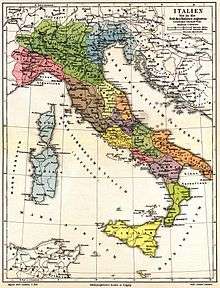
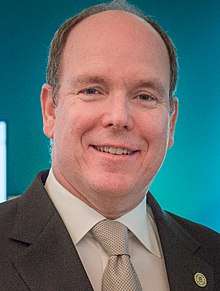
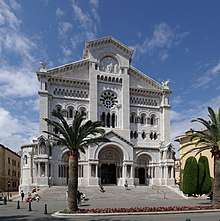
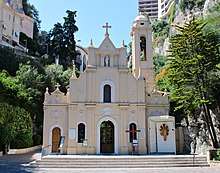
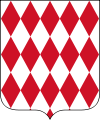
.svg.png)
